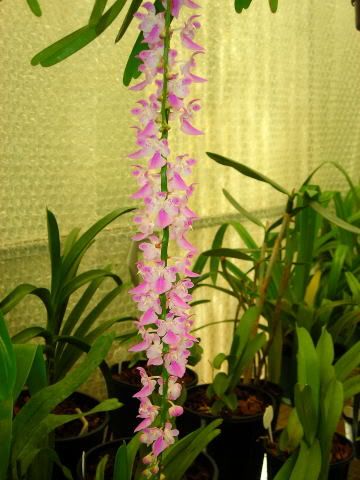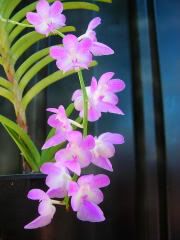


Donate Now
and become
Forum Supporter.

Many perks!
<...more...>


|

09-10-2008, 08:28 AM
|
|
Senior Member
|
|
Join Date: Feb 2007
Zone: 5a
Location: fishers, indiana
Age: 58
Posts: 3,065
|
|
 Aerides seasonal care
Aerides seasonal care
I grow a few aerides species and just wanted to learn how some of you might be growing your plants. Specifically, do you give them different care depending on the season? I know that many (most?) grow in monsoon-prone areas of the world, where they withstand hot and wet growing seasons followed by a relatively cool and dry dormant season. But how many of you try to duplicate this--and if you do attempt to follow nature's lead, how dry and cool do you let your plants get? Thanks!
Steve
|
|
Post Thanks / Like - 1 Likes
|
|
|
|
|

09-10-2008, 10:04 AM
|
|
Senior Member
|
|
Join Date: Jan 2008
Location: Australia
Posts: 1,669
|
|
I grow my aerides in a green house that I heat as best I can. The temp range is from 8c at the worst to 35c at the hottest. I grow them in mesh basket with coarse bark. I water them every 2 or 3 days in the winter and if possible every day in summer. I feed them lightly every 2nd watering in summer & once a week in winter. All but one are hanging close to the roof and are kept in about 60% shade. These plants I treat like Paphs, Vandas etc. There are continuous growers & have no bulb to store food. Good air movement and reasonable humidity is required. Here is a very recent pic I took.

This is a couple in flower.

 |

09-10-2008, 11:39 AM
|
|
Senior Member
|
|
Join Date: Aug 2008
Posts: 256
|
|
Aerides krabiensis, A. multiflora and A. rosea (fieldingii) should have somewhat reduced watering during the winter. All other species should be grown warm and wet the entire year (provided they have healthy roots). In general water once a day and a second time durng really hot periods. Once established with multiple growths it is hard to overwater them.
Eric
|

09-10-2008, 01:04 PM
|
|
Senior Member
|
|
Join Date: Feb 2007
Zone: 5a
Location: fishers, indiana
Age: 58
Posts: 3,065
|
|
Thanks, guys, for your feedback.
Roy, do you have A. odorata and/or A. quinquevulnera? If so, when (and how often) do they generally flower? Thank you for including the pictures. It's always beneficial to see how other growers raise their plants.
Steve
|

09-10-2008, 10:19 PM
|
|
Senior Member
|
|
Join Date: Jan 2008
Location: Australia
Posts: 1,669
|
|
Quote:
Originally Posted by smweaver

Thanks, guys, for your feedback.
Roy, do you have A. odorata and/or A. quinquevulnera? If so, when (and how often) do they generally flower? Thank you for including the pictures. It's always beneficial to see how other growers raise their plants.
Steve
|
Steve, I have A. quinquev' v Purpureum which is a smaller grower then the white/spotted var and I flower it every year. I also have an Odorata that has been flowering size for the last 4 years and its still yet to bloom, not sure what I am doing wrong, the plant is very good ( pictured in group, far right ).
I respect the comments of others but the comment about apart from the 3 Aer's mentioned, the others should be kept warm & wet I have found the this is definitely NOT the case. I & others with these plants have found to keep them in those conditions causes rot in the plant. I grow 7 different Aerides in the same culture with great success, apart from the Odorata not flowering. |

09-10-2008, 10:44 PM
|
|
Senior Member
|
|
Join Date: Aug 2008
Posts: 256
|
|
Hey Roy,
My comments are for plants grown under much brighter light levels than yours and as I said - once they have multiple growths! Yours are single growth plants under rather low light levels. So one needs to pull back on the watering accordingly. However, odds are that your A. odorata hasn't flowered because it wants more light. The finest plants of this species are on exposed trunks of street trees in Malaysia and Indonesia where they get full morning and afternoon sun. There the form clumps 15 ft. tall and 10-12 ft wide. If your humidity allows, you might put the plants outside for the summer.
I grew them best in equal parts of medium bark and equal sized hardwood charcoal in terra cotta pots in a single pane glass greenhouse in New England. Escept on the very greyest days of winter, the plants were thoroughly watered every day and loved it.
Eric
|
|
Post Thanks / Like - 1 Likes
|
|
|
|
|

09-11-2008, 11:48 AM
|
|
Senior Member
|
|
Join Date: Feb 2007
Zone: 5a
Location: fishers, indiana
Age: 58
Posts: 3,065
|
|
I am growing mine in fairly high light; they've been acclimated to handle direct sunlight from 7 A.M. to around 2 P.M. during the summer growing period when they're outside, and our summer temperatures and humidity levels are consistently high. They're also growing in clay pots with no potting medium (see picture of one of them below) and get completely immersed each morning for about half an hour in a bucket of water so that roots and pot are completely saturated before I head off to work. So maybe I would be able to get away with watering them fairly often during the winter? They spend the winters in a southwest-facing sunroom that gets decent light. I'm just trying to determine whether or not seasonal differences in the amounts of light and water/fertilizer are what trigger the plants to flower--since my A. odorata (like Roy's) also is rather stubborn and hasn't flowered for me during the last few years.
Steve

 |

09-11-2008, 12:38 PM
|
|
Senior Member
|
|
Join Date: Aug 2008
Posts: 256
|
|

Hey Steve,
Your plant is very happy and the leaves are just the right shade of green. Do not change a thing!
However, your plant is still rather small. Aerides odorata will flower on a very small plant if you stress it - higher light and(or) a prolonged dry period (both of which alter the carbon to nitrogen ratio in the plant). I don't recommend this. Instead just keep growing it and when it is about twice the current size you should start getting pups at the base. Once it gets to that size it should flower regularly withough any need to modify conditions. I don't think it needs a stimulus to flowers - stress simply over rides everything and makes it flower.
Give it high nitrogen fertilizer and keep pushing vegetative growth for the next 1-2 years. Once the plant gets larger each shoot should have 2-4 inflorescences at a time.
I found the odorata complex - and especially A. lawrenciae - needs to grow well for a couple of years and it suddenly bursts into vigor - like turning on a light switch.
Like I said, your plant is happy and don't change a thing.
Eric

|

09-11-2008, 12:44 PM
|
|
Senior Member
|
|
Join Date: Nov 2006
Location: Michigan
Posts: 2,063
|
|
Steve
Where do you find your pots? They look great for growing with all the holes. Marilyn
|

09-11-2008, 12:57 PM
|
|
Senior Member
|
|
Join Date: Jan 2008
Location: Australia
Posts: 1,669
|
|
Eric, I have a Aer lawrenceae which is nearly 4 foot tall and flowers with at least 2 spike every year. It is only this year producing an offshoot. This multi growth plant to flower stuff might be applicable to some growers but is definitely not general. I personally have found that if the plant is healthy and growing well it will flower off a mature size plant and every year. As with many orchids, the Maturity of the plant is the key word.
|
|
Currently Active Users Viewing This Thread: 1 (0 members and 1 guests)
|
|
|
 Posting Rules
Posting Rules
|
You may not post new threads
You may not post replies
You may not post attachments
You may not edit your posts
HTML code is Off
|
|
|
All times are GMT -4. The time now is 01:58 PM.
|





































 Linear Mode
Linear Mode


